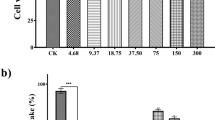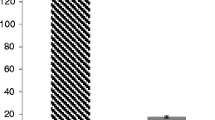Abstract
Helichrysum sanguineum is a traditional Palestinian medicinal plant used for the treatment of various diseases. The current investigation aimed to estimate H. sanguineum four fractions chemical compositions, antioxidant, anti-lipase, and anti-α-amylase activities. Phytochemical screening, total phenols, flavonoids, and tannins of H. sanguineum acetone, aqueous, methanol, and hexane fractions were carried out using standard analytical methods. In contrast, the free radical scavenging properties of these fractions were determined using the colorimetric DPPH method and Trolox as a positive control. Moreover, the anti-lipase activity was estimated using porcine pancreatic lipase enzyme inhibitory assay and Orlistat as a positive control. Also, the α-amylase inhibitory activity was established by utilizing the α-amylase porcine pancreatic enzyme and the 3,5-dinitrosalicylic acid (DNSA) method with Acarbose as a positive control. The obtained results showed that the H. sanguineum hexane fraction has the highest phenol and flavonoid contents and revealed the best antioxidant activity. Moreover, the aqueous fraction of H. sanguineum showed potential inhibitions against α-amylase and lipase porcine pancreatic enzymes in comparison with Acarbose and Orlistat, respectively. This study endorses the use of the H. sanguineum aqueous fraction for further in vivo studies to determine its potential against diabetes mellitus, obesity, and oxidative stress diseases.






Similar content being viewed by others
Data Availability
All the utilized data to support the findings of the current study are included within the article.
References
Al-Lahham, S.; Sbieh, R.; Jaradat, N.; Almasri, M.; Mosa, A.; Hamayel, A.; et al.: Antioxidant, antimicrobial and cytotoxic properties of four different extracts derived from the roots of Nicotiana tabacum L. Eur. J. Integr. Med. 33, 101039 (2020)
Jaradat, N.; Qadi, M.; Abualhasan, M.N.; Al-lahham, S.; Al-Rimawi, F.; Hattab, S.; et al.: Carbohydrates and lipids metabolic enzymes inhibitory, antioxidant, antimicrobial and cytotoxic potentials of Anchusa ovata Lehm from Palestine. Eur. J. Integr. Med. (2020). https://doi.org/10.1016/j.eujim.2020.101066
Carini, F.; Tomasello, G.; Jurjus, A.; Geagea, A.; Al Kattar, S.; Damiani, P.; et al.: Colorectal cancer and inflammatory bowel diseases: effects of diet and antioxidants. J. Biol. Regul. Homeost. Agents 31(3), 791–795 (2017)
Tylavsky, F.A.; Ferrara, A.; Catellier, D.J.; Oken, E.; Li, X.; Law, A.; et al.: Understanding childhood obesity in the US: the NIH environmental influences on child health outcomes (ECHO) program. Int. J. Obes. 44, 617–627 (2020)
Jaradat, N.; Zaid, A.N.; Hussein, F.; Zaqzouq, M.; Aljammal, H.; Ayesh, O.: Anti-lipase potential of the organic and aqueous extracts of ten traditional edible and medicinal plants in palestine; a comparison study with Orlistat. Medicines 4(4), 89–95 (2017)
Brauer, P.; Gorber, S.C.; Shaw, E.; Singh, H.; Bell, N.; Shane, A.R.; et al.: Recommendations for prevention of weight gain and use of behavioural and pharmacologic interventions to manage overweight and obesity in adults in primary care. Can. Med. Assoc. J. 187(3), 184–195 (2015)
Olokoba, A.B.; Obateru, O.A.; Olokoba, L.B.: Type 2 diabetes mellitus: a review of current trends. Oman Med. J. 27(4), 269–274 (2012)
Kazeem, M.; Adamson, J.; Ogunwande, I.: Modes of inhibition of α-amylase and α-glucosidase by aqueous extract of Morinda lucida Benth. leaf. Int. BioMed. Res. (2013). https://doi.org/10.1155/2013/527570
Boi, M.: The Ethnocultural Significance for the Use of Plants in Ancient Funerary Rituals and Its Possible Implications with Pollens Found on the Shroud of Turin. Valencia, Italy (2012)
Jaradat, N.; Al-Masri, M.; Zaid, A.N.; Hussein, F.; Shadid, K.A.; Al-Rimawi, F.; et al.: Assessment of the antimicrobial and free radical scavenging activities of Moluccella spinosa, Helichrysum sanguineum, and Styrax officinalis folkloric medicinal plants from Palestine. Orient. Pharm. Exp. Med. 18(2), 107–114 (2018)
Erolu, E.H.; Hamzaolu, E.; Aksoy, A.; Budak, Ü.; Özkul, Y.: In vitro genotoxic effects of four Helichrysum species in human lymphocytes cultures. Biol. Res. 43(2), 177–182 (2010)
Giovanelli, S.; De Leo, M.; Cervelli, C.; Ruffoni, B.; Ciccarelli, D.; Pistelli, L.: Essential oil composition and volatile profile of seven Helichrysum species grown in Italy. Chem. Biodivers. 15(5), e1700545 (2018)
Mericli, A.; Cubukcu, B.; Dortunc, T.: Flavoroids and anthocyanins of Helichrysum Sanguineum. Fitoterapia 55, 112–115 (1984)
Albayrak, S.; Sagdic, O.; Aksoy, A.; Hamzaoglu, E.: Antimicrobial and antioxidant activities of Helichrysum species from the Mediterranean region of Turkey. Asian J. Chem. 20(4), 3143 (2008)
Michel, C.; El-sherei, M.; Islam, W.; Sleem, A.; Ahmed, S.: Bioactivity-guided fractionation of the stem bark extract of Pterocarpus dalbergioides Roxb. ex Dc growing in Egypt. Bull. Fac. Pharm. Cairo Univ. 51(1), 1–5 (2013)
Trease, G.; Evans, W.: Pharmacognosy. Baillier Tindall, London (1983)
Cartwright, A.C.: The British Pharmacopoeia, 1864 to 2014: Medicines, International Standards and the State. Routledge, London (2016)
Jaradat, N.; Adwan, L.; K’aibni, S.; Shraim, N.; Zaid, A.N.: Chemical composition, anthelmintic, antibacterial and antioxidant effects of Thymus bovei essential oil. BMC Complement. Altern. Med. 16(1), 418–424 (2016)
Jaradat, N.; Hussen, F.; Al Ali, A.: Preliminary phytochemical screening, quantitative estimation of total flavonoids, total phenols and antioxidant activity of Ephedra alata Decne. J. Mater. Environ. Sci. 6(6), 1771–1778 (2015)
Chang, C.-C.; Yang, M.-H.; Wen, H.-M.; Chern, J.-C.: Estimation of total flavonoid content in propolis by two complementary colorimetric methods. J. Food Drug Anal. 10(3), 178–182 (2002)
Sun, B.; Ricardo-da-Silva, J.M.; Spranger, I.: Critical factors of vanillin assay for catechins and proanthocyanidins. J. Agric. Food Chem. 46(10), 4267–4274 (1998)
Bustanji, Y.; Issa, A.; Mohammad, M.; Hudaib, M.; Tawah, K.; Alkhatib, H.; et al.: Inhibition of hormone sensitive lipase and pancreatic lipase by Rosmarinus officinalis extract and selected phenolic constituents. J. Med. Plants Res. 4(21), 2235–2242 (2010)
Drent, M.; Larsson, I.; William-Olsson, T.; Quaade, F.; Czubayko, F.; Strobel, W.; et al.: Orlistat (Ro 18-0647), a lipase inhibitor, in the treatment of human obesity: a multiple dose study. Int. J. Obes. Relat. Metab. Disorder 19(4), 221–226 (1995)
McCue, P.P.; Shetty, K.: Inhibitory effects of rosmarinic acid extracts on porcine pancreatic amylase in vitro. Asia. Pac. J. Clin. Nutr. 13(1), 12–20 (2004)
Ojo, O.A.; Ojo, A.B.; Ajiboye, B.; Olayide, I.; Fadaka, A.: Helianthus annuus leaf Ameliorates postprandial hyperglycaemia by inhibiting carbohydrate hydrolyzing enzymes associated with type-2 diabetes. Iran. J. Toxicol. 10(5), 17–22 (2016)
Alali, F.Q.; Tawaha, K.; El-Elimat, T.; Syouf, M.; El-Fayad, M.; Abulaila, K.; et al.: Antioxidant activity and total phenolic content of aqueous and methanolic extracts of Jordanian plants: an ICBG project. Nat. Prod. Res. 21(12), 1121–1131 (2007)
Albayrak, S.; Aksoy, A.; Sagdic, O.; Hamzaoglu, E.: Compositions, antioxidant and antimicrobial activities of Helichrysum (Asteraceae) species collected from Turkey. Food Chem. 119(1), 114–122 (2010)
Ajiboye, B.O.; Ojo, O.A.; Adeyonu, O.; Imiere, O.; Olayide, I.; Fadaka, A.; et al.: Inhibitory effect on key enzymes relevant to acute type-2 diabetes and antioxidative activity of ethanolic extract of Artocarpus heterophyllus stem bark. J. Acute Dis. 5(5), 423–429 (2016)
Ibrahim, M.A.; Koorbanally, N.A.; Islam, M.S.: Antioxidative activity and inhibition of key enzymes linked to type-2 diabetes (α-glucosidase and α-amylase) by Khaya senegalensis. Acta Pharm. 64(3), 311–324 (2014)
Ademiluyi, A.O.; Oboh, G.: Soybean phenolic-rich extracts inhibit key-enzymes linked to type 2 diabetes (α-amylase and α-glucosidase) and hypertension (angiotensin I converting enzyme) in vitro. Exp. Toxicol. Pathol. 65(3), 305–309 (2013)
Shaw, J.E.; Sicree, R.A.; Zimmet, P.Z.: Global estimates of the prevalence of diabetes for 2010 and 2030. Diabetes Res. Clin. Pract. 87(1), 4–14 (2010)
Kim, G.-N.; Shin, M.-R.; Shin, S.H.: Study of antiobesity effect through inhibition of pancreatic lipase activity of Diospyros kaki fruit and Citrus unshiu peel. Int. BioMed Res. (2016). https://doi.org/10.1155/2016/1723042
Maiti, B.; Nagori, B.; Singh, R.: Recent trends in herbal drugs: a review. Int. J. Drug Res. Technol. 1(1), 20–31 (2017)
Huyut, Z.; Beydemir, Ş.; Gülçin, İ.: Antioxidant and antiradical properties of selected flavonoids and phenolic compounds. Biochem. Res. Int. (2017). https://doi.org/10.1155/2017/7616791
Ivanović, S.; Avramović, N.; Dojčinović, B.; Trifunović, S.; Novaković, M.; Tešević, V.; et al.: Chemical composition, total phenols and flavonoids contents and antioxidant activity as nutritive potential of roasted hazelnut skins (Corylus avellana L.). Foods 9(4), 430–437 (2020)
Yahia, Y.; Benabderrahim, M.A.; Tlili, N.; Hannachi, H.; Ayadi, L.; Elfalleh, W.: Comparison of three extraction protocols for the characterization of caper (Capparis spinosa L.) leaf extracts: evaluation of phenolic acids and flavonoids by liquid chromatography–electrospray ionization–tandem mass spectrometry (LC–ESI–MS) and the antioxidant activity. Anal. Lett. 53, 1–12 (2020)
Kopustinskiene, D.M.; Jakstas, V.; Savickas, A.; Bernatoniene, J.: Flavonoids as anticancer agents. Nutrients 12(2), 457–462 (2020)
Mowl, A.; Alauddin, M.; Rahman, M.; Ahmed, K.: Antihyperglycemic effect of Trigonella foenum-graecum (Fenugreek) seed extract in alloxan-induced diabetic rats and its use in diabetes mellitus: a brief qualitative phytochemical and acute toxicity test on the extract. Afr. J. Tradit. Complement. Altern. Med. 6(3), 255–261 (2009)
Geberemeskel, G.A.; Debebe, Y.G.; Nguse, N.A.: Antidiabetic effect of fenugreek seed powder solution (Trigonella foenum-graecum L.) on hyperlipidemia in diabetic patients. J. Diabetes Res. (2019). https://doi.org/10.1155/2019/8507453
Molehin, O.R.; Elekofehinti, O.O.; Oyeyemi, A.O.: Antihyperlipidemic, antiperoxidative and hypoglycemic effects of saponins from Solanum anguivi Lam. fruits in alloxan-induced diabetic rats. FASEB J (2020). https://doi.org/10.1096/fasebj.2020.34.s1.00510
Yang, R.; Jiang, X.; He, X.; Liang, D.; Sun, S.; Zhou, G.: Ginsenoside Rb1 improves cognitive impairment induced by insulin resistance through Cdk5/p35-NMDAR-IDE pathway. Biomed. Res. Int. (2020). https://doi.org/10.1155/2020/3905719
Acknowledgements
The authors would like to acknowledge the Faculty of Medicine and Health Sciences at An-Najah National University for facilitating the accomplishment of the current study.
Author information
Authors and Affiliations
Contributions
The current research done by the authors.
Corresponding author
Ethics declarations
Conflict of interest
All authors declare that they have no conflict of interest.
Rights and permissions
About this article
Cite this article
Jaradat, N., Qneibi, M., Hawash, M. et al. Chemical Composition, Antioxidant, Antiobesity, and Antidiabetic Effects of Helichrysum sanguineum (L.) Kostel. from Palestine. Arab J Sci Eng 46, 41–51 (2021). https://doi.org/10.1007/s13369-020-04707-z
Received:
Accepted:
Published:
Issue Date:
DOI: https://doi.org/10.1007/s13369-020-04707-z




